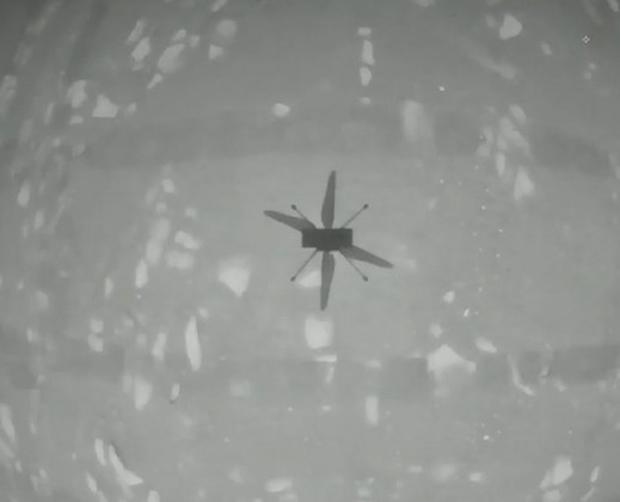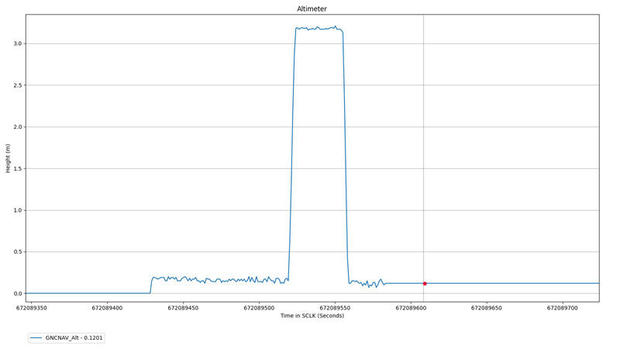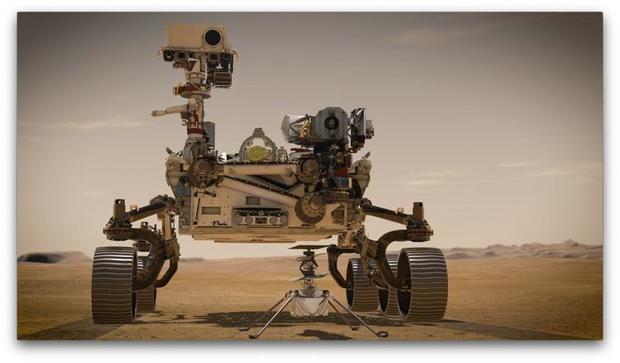NASA's Ingenuity helicopter makes maiden flight on Mars in a "Wright brothers moment"
After overcoming an earlier software glitch, NASA's $80 million Ingenuity helicopter spun up its carbon-composite rotors and lifted off the dusty surface of Mars early Monday to become the first aircraft to fly on another planet, a "Wright brothers moment" that could pave the way to future interplanetary aircraft.
Tipping the scales at just 4 pounds — 1.5 pounds in the lower gravity of Mars — Ingenuity's counter-rotating 4-foot-long rotors, spinning at more than 2,500 rpm, were commanded to change their pitch, "biting" deeper into the thin atmosphere for a liftoff from the floor of Jezero Crater around 3:30 a.m. EDT.
With the Perseverance rover looking on from a safe distance, Ingenuity climbed 10 feet straight up, hovered, turned in place and then landed to complete a test flight spanning just 40 seconds or so.
That was more than enough to make space history.
"We can now say human beings have flown a rotorcraft on another planet!" an elated MiMi Aung, the Ingenuity project manager at NASA's Jet Propulsion Laboratory, told her socially distanced team. "We've been talking so long about our Wright brothers moment on Mars, and here it is.
"We don't know from history what Orville and Wilbur did after their first successful flight. I imagine the two brothers hugged each other. Well, I'm hugging you virtually right now. ... We together flew at Mars, and we together have our Wright brothers moment."
Appropriately enough, the helicopter carried a postage stamp-size piece of fabric from the Wright brothers' first biplane. To honor the pioneering aviators, NASA named Ingenuity's test site in Jezero Craer "Wright Brothers Field."
Like the historic 1903 flight, Ingenuity's was dramatic, especially given it took three hours for data confirming a successful takeoff and landing to make its way to Earth, relayed through NASA's Mars Reconnaissance Orbiter. Once finally on its way, the telemetry took nearly 16 minutes to cross the 178-million-mile gulf between Mars and Earth.
The data began showing up on computer screens at JPL just after 6:30 a.m. Peering intently at his display, JPL's "pilot," Håvard Grip, announced the results, confirming Ingenuity "performed spin up, take off, climb, hover, descent, landing, touchdown and spin down."
"Dare Mighty Things"
"Altimeter data confirms that Ingenuity has performed the first flight of a powered aircraft on another planet!" he said as engineers burst into cheers and applause.
Moments later, initial images were displayed, including a short video shot by Perseverance showing the small helicopter lifting off, hovering and setting down. A sharp black-and-white still image, taken by a camera aboard Ingenuity, showed the helicopter's shadow on the surface of Mars, its rotors sharply defined.
As each image appeared on a screen at the front of the control room, the engineering team cheered and applauded with evident relief. The motto emblazoned on their wall reads, "Dare Mighty Things."
"What we had instructed Ingenuity to do was to climb to an altitude of three meters, hover there for a little bit, about five seconds, then make a turn of about 96 degrees, hover for another 20 seconds and then go to land again in the same place that it took off from," Grip told reporters later.
"That's what he told Ingenuity to do, and it did exactly that. And it did it just perfectly. From everything we've seen so far, it was a flawless flight."
Ingenuity's short up-and-down maiden flight might sound trivial given the performance of inexpensive drones on Earth.
But consider that Ingenuity has to fly in a mostly carbon dioxide atmosphere just 1% as thick as Earth's — the equivalent of altitudes three times higher than Mount Everest — on a planet so far away direct human control isn't possible and where the temperature drops to 130 degrees below zero at night.
Based on the results of Ingenuity's mission, more sophisticated drones may eventually be sent to Mars and elsewhere in the solar system to carry cameras and compact but sophisticated science instruments to locales that are not accessible to rovers or astronauts — places like crater walls and rims, canyons and gorges.
"I will be very disappointed in the science community and technology community if they don't come up with something utterly amazing because of the new dimension that was added by this technology to explore," said NASA science chief Thomas Zurbuchen.
Ingenuity was carried to Mars bolted to the belly of the Perseverance rover, which landed in Jezero Crater on February 18. The rover later dropped the helicopter to the surface and backed away to observe the first of up to five short test flights.
Equipped with two cameras, the helicopter does not carry any science instruments. It was added to Perseverance's mission solely to determine the feasibility of powered flight in the red planet's thin atmosphere.
Rooting out Ingenuity's flight issue
The initial test flight originally was planned for April 11. But two days earlier, a rotor spin-up test was aborted by the helicopter's flight software when it failed to transition to flight mode as planned.
Engineers at JPL reviewed telemetry and came up with two solutions. One required uplinking a few additional commands to the control software, an approach expected to work about 85% of the time.
The other option was to replace the flight software with a modified version that's been uplinked and stored aboard Perseverance. That would completely eliminate the problem, but it would require several more days to implement and introduce at least a slight element of additional risk.
After a detailed analysis, the helicopter team went with the first option and to everyone relief, there were no problems.
Up to four more test flights are planned over the next two weeks, pushing the helicopter to slightly higher altitudes and more far-ranging traverses to put its compact systems through their paces.
For its second flight, the drone will climb to 16 feet, move 6.5 feet to one side and then come back to its starting point for landing. For its third flight, Ingenuity will again climb to 16 feet before flying 160 feet or so out and back. During its final flights, it may climb as high as 30 feet and range hundreds of feet from Perseverance.
"We want to push it to the limit," Aung said. "We want to push against the wind, we want to push against the speed and ultimately, we expect the helicopter will meet its limit. But that information is extremely important. ... We really want to know what the limits are."
When the test flights are complete, Perseverance will move on to its primary science mission, searching for signs of past microbial life in ancient lakebed deposits on the floor of Jezero Crater. Ingenuity will be left behind at Wright Brothers Field and with it, a small patch of fabric from Earth's first true airplane.









